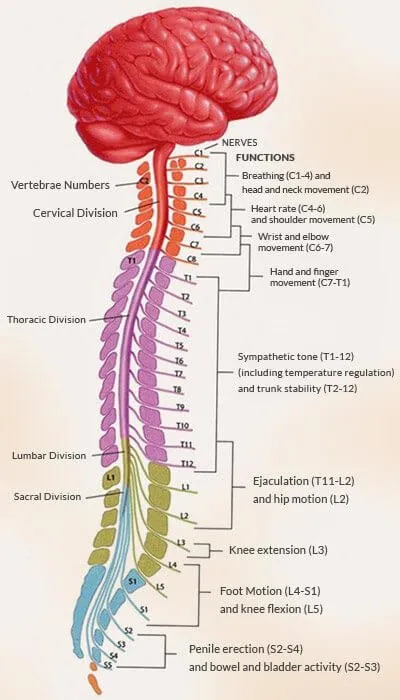31 Spinal Cord Parts and Functions – Facts and Diseases
Extending right from the medulla oblongata and running through vertebral column in your body, it resembles a long, thin, tubular structure that is composed of nervous tissue and the accessory cells. There are witnessed slight gender-based variations in the length of neural column in your backbone, i.e. it is about 45cm and 43cm long in human males and females, respectively.
Performing the role of a bridge or mediating organ, its upper end lies at the level of occipital bone, while the lower end meets lumbar vertebrae. Though primary function of the spinal cord is to conduct motor and sensory information, it does have an independent role of coordinating certain reflexes and central pattern generators.
Traumatic injuries and severe ailments in the region disrupt the overall functioning of the central and peripheral nervous systems, usually resulting in the inactivity of the subordinate organs.
Parts of Spinal Cord
 Measuring up to 18 inch in length, the dorsal neural tube gradually decreases in width while running downwards in the vertebral column, i.e. at the cervical regions the thickness is about 1/2 inch while reaching the lumbar vertebrae the size is reduced to just 1/4 inches in diameter.
Measuring up to 18 inch in length, the dorsal neural tube gradually decreases in width while running downwards in the vertebral column, i.e. at the cervical regions the thickness is about 1/2 inch while reaching the lumbar vertebrae the size is reduced to just 1/4 inches in diameter.
However, it is comparatively shorter in length than your bony spinal column and does not run along its entire length. On the whole, the ovoid structure of neural tube can be subdivided into 33 segments in human beings.
Based on their association with the different regions of vertebrae, these segments can be grouped into five broader categories which are briefly described as under:
Cervical Segments
Being the anterior most segments of the spinal cord that run across seven cervical vertebrae, it is located along the neck region. The upper portion forms as many as eight pairs of cervical nerves which are named with the vertebra they emerge from, viz. C1, C2, C3, C4, ? C8. However, the C8 pair of cervical nerve emerges from the lower end of the C7 vertebral segment while all of other pairs emerge from the upper end of the respective vertebra.
Thoracic Segments
Running along the series of twelve T vertebrae in the thoracic region, they constitute 12 pairs of thoracic nerves each of which leaving the vertebral column below the associated vertebral division.
Lumbar Segments
It is one of the parts of spinal cord that is protected by five lumbar vertebrae, it gives rise to five pairs of nervous extensions each of which emerges below the associated vertebra.
Sacral Segments
The same is the case with this region, i.e. five sacral nerve pairs leave your backbone just beneath each bony segment and are named as S1, S2, S3, S4 and S5.
Coccygeal Segments
The lower most portion of the neural tube that gives rise to one pair of coccygeal nerves and leaves the vertebrae through sacral hiatus. However, here you will find that three segments of the region fuse together to form a single unit.
Functions of Spinal Cord
Being the second most important and complementary part of CNS (Central Nervous System), it not only connects the brain with PNS (Peripheral Nervous System), but also performs a multitude of essential neural functions in your body. You can rightly call it the "information highway of your body" as it maintains round-the-clock communication between the master organ (brain) and the rest of your structures.
Two-way Transmission of Nerve Signals
Two types of nerve impulses travel along the neural column, i.e. motor and sensory nerves, each running in opposite direction relative to the other. While motor nerves originate from your brain and travel downwards to reach the peripheral parts of your body, sensory information is collected from various parts of the sensory organs (skin, eyes, ears, tongue and nose) and are delivered to the brain for processing and generation of appropriate response.
Control of Reflexes
Another major task of this part of your CNS is the independent control and coordination of central nerve generators and certain reflexes. Such actions protect your body against dangerous stimuli by the generation and application of a quick response. Under such circumstances, the prolongation of response may inflict an irreparable damage to your body.
Diseases of Spinal Cord
Ailments of the spinal nerve column are generally referred to as the disorders of central nervous system as it is its second major component. Besides injuries, a number of diseases have been identified affecting the region, viz. infections, inflammations, tumors, and degenerative disorders.
Such spinal abnormalities are revealed through different clinical manifestations, like the loss of sensation, numbness, severe pain, and muscle weakness. The symptoms usually occur around the spinal cord but may also spread to arms and legs.
For their amelioration, your health care provider may advise you different treatment measures mainly depending on the type and severity of the disorder, but the most frequently recommended strategies include drug administration and surgical therapy.


